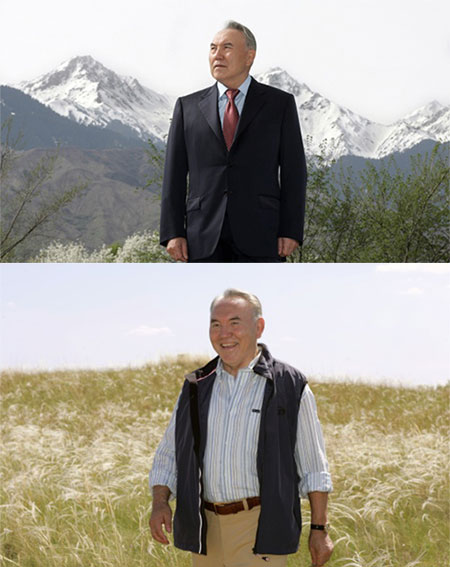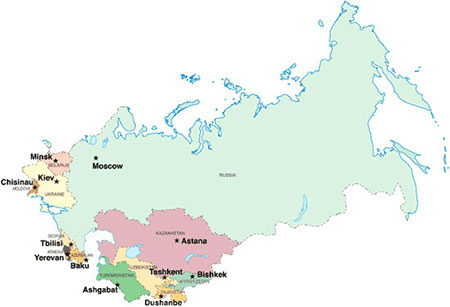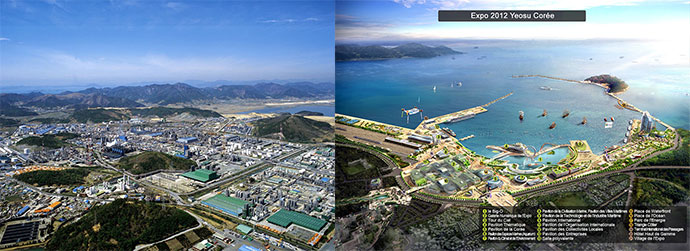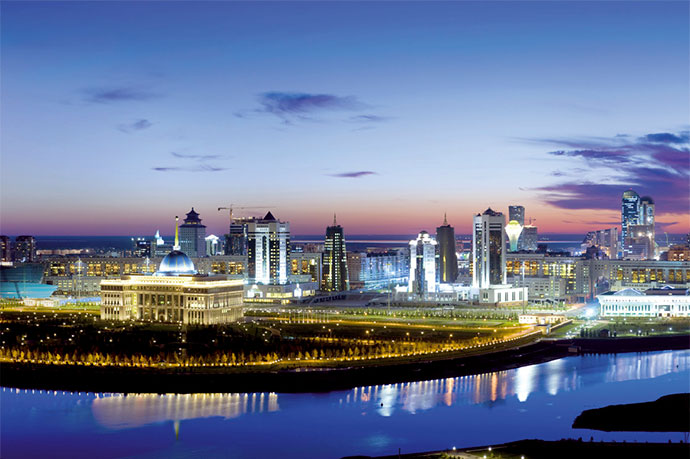
“Sky of golden sun,
Steppe of golden seed,
Legend of courage —
Take a look at my country!”
— from the anthem of the Republic of Kazakhstan
The spoken and written works of prolific Kazakhstan President Nursultan Nazarbayev include the lyrics to the republic’s national anthem, as well as such statements as “Each and everyone must do sports — sports strengthen spirit,” and “The one who aspires to victory wins.”
Those competitive sentiments were satisfied on Nov. 22, 2012, when 103 of the 161 member states of the International Expositions Bureau (BIE) voted in Paris in favor of the country’s bid to host the International EXPO 2017 on the theme of “Future Energy.” The event will take place in the city of Astana, a new municipality built from scratch on the empty steppe over the past 15 years, and the home of the relocated national capital, formerly in Almaty, since 1997.
There are precedents for national capital relocations, but not many, and they’re not always models to emulate in terms of capital allocation. As noted in this space by late Site Selection publisher and founder McKinley Conway, Brazil’s move of its capital from Rio to Brasilia qualified as a top megaproject of the 20th century. But its dilapidated and obsolete grounds today are looked to more as an art object than a thriving government-driven utopia. Nigeria’s move of the capital from Lagos to Abuja produced “questionable results,” wrote Conway. Argentina proposed moving its capital from Buenos Aires to Viedma, but nothing happened. And big capital moves in Japan and South Korea (the latter with a projected $45-billion price tag) have yet to occur.
However, “Germany made a smooth $16-billion move to relocate from Bonn back to Berlin after reunification,” Conway noted, setting an apt precedent for Kazakhstan, given the breakup of the Soviet Union and subsequent “reunification” of sorts under the aegis of the Commonwealth of Independent States (CIS), a loose union of the former Soviet territories.
Nazarbayev cites precedents going much further back in time.
“The idea of creating a new capital for Kazakhstan dates back to the first days of our independence,” he writes of that momentous occasion on the winter solstice in 1991. “I remember His Majesty, Juan Carlos, King of Spain, telling me how King Philip II moved Spain’s capital from Toledo to Madrid, and how that was a controversial move. A benchmark for ‘new’ capitals is Washington — which was created in a deserted district following the instructions of George Washington, the first U.S. president. Back then the decision had huge political value as a symbol of independence from the British crown. In Russia, the change of capital, on two separate occasions, has had undisputed historical significance.”
Why did the Kazakh capital relocate? The official reasons were Almaty’s earthquake-prone geology and, like many an organization, the lack of space for expansion. The move began in 1994 and ended in 1997. Today the city bustles with more than 700,000 people representing more than 100 nationalities, a mark below Nazarbayev’s projection of 1 million by 2010, but a nonetheless impressive three-fold increase since 1998.
The 2017 Expo decision marks the first time that a BIE event has been awarded to a CIS city. Astana beat out runner-up Liège, Belgium, in Wallonia, where there was muttering about the unfairness of going up against oil money, but also a feeling that the effort alone had unified the region for better things ahead. Certainly that feeling is afoot on the steppe.
“The opportunity of holding the EXPO in our capital is a wonderful chance to develop and disseminate this global idea from the very heart of the Eurasian landmass,” said the mayor of Astana, Imangali Tasmagambetov. “We aspire to, believe in and are capable of changing the world for the better! This is the real reason why Astana is taking part in this truly grandiose project.”
He may have meant to say simply “grand,” but the more you know about Astana, the more you might think “grandiose” is a downplay.
Aspiration and Integration
Astana has been called a lot of things, from “City of the Future” to, in a 2011 New Yorker profile, “Nowheresville.” All of those terms could conceivably be applied to any Expo site, which like an Olympic Village essentially functions as a pop-up exhibition city, notwithstanding planners’ well-documented promises of future reuse.
In the case of Kazakhstan and its capital city, however, the drama and weight of the past are never far away, and anchor the nation’s bid in a sense of national character.

Besides being one of the world’s most northerly national capitals, Astana is located near one of the most notorious concentration camps of the Gulag archipelago. At one time part of Nikita Khrushchev’s “Virgin Lands” plan to produce grain for the entire USSR, the Kazakh territory benefited from an influx of agricultural investment and ag workers. But Kazakhstan was also the Soviet Union’s chosen location for nuclear weapons testing.
President Nazarbayev may be one of the few national presidents to maintain an extensive personal Web page. In a missive prior to taking part in nuclear weapon security talks last year, he wrote, “The nuclear threat strikes a deep chord within Kazakhstan. For four decades, our country was used as the backdrop for nuclear tests. By the time the Semipalatinsk site was closed, there had been nearly 460 explosions, including 116 nuclear bombs exploded above ground. Although it has been well over 20 years since the last test, their devastating impact is still being felt. Many thousands of our people have died early because of their exposure to radioactive fallout. Cancer rates and birth abnormalities remain far higher in the affected region than in the rest of the country. Children continue to be born with mental and physical defects. This tragic legacy helps explain the passionate commitment of our people to help lift the shadow of nuclear weapons from our world.”
The economic tide has turned in Kazakhstan with the incremental discovery and exploration of massive untapped oil reserves. Kazakhstan now is among the top 15 countries in the world when it comes to essential oil reserves, with 3 percent of the world’s total oil reserves. Sixty-two percent of the country is occupied by oil and gas areas, and there are 172 oil fields, of which more than 80 are under development. Proven onshore and offshore oil reserves total 35 billion barrels. And speculation is strong that additional reserves under the Kazakh section of the Caspian Sea may total as much as 124 billion more barrels, thanks to the discovery of the Kashagan oil field there in 2000.
Thus Kazakh industrial development is leading the CIS parade. A project database maintained by the national agency for export and investment, Kaznex Invest, shows 218 active projects ranging from the “construction of four satellite towns” in the Almaty region to new metals, pipe, concrete and chemical plants representing tens of billions in capital investment. Most of them feature major injections of money from the state. But they also reflect the continuing growth of private-sector investment in the manufacture of consumer products, whether toilet paper or automobiles.
Of course, given that the primary export is oil, the internal financing doesn’t mean inward focus. According to the Interstate Statistical Committee of the CIS, in 2012 Kazakhstan had more than $84.8 billion in exports, second only to Russia’s $477.5 billion, and representing 39 percent of exports from all of the non-Russian CIS countries. Moreover, 86 percent of those exports were destined for places beyond the CIS.
The nation has been aided by its internal network of free economic zones. But Nazarbayev has also been a champion of a single economic space in all of Eurasia. After early efforts in the 1990s were unsuccessful, an early version of a CIS customs union encompassing just Kazakhstan, Belarus and Russia spurred dramatic increases in cross-border trade among the three countries. A comprehensive customs union for the three countries — Single Economic Space, or SES — became official on January 1, 2012. Nazarbayev sees it as just the beginning of a new “EU” or Eurasian Union, driven not by dreams of the old USSR or worries about China, but by fundamental and practical concerns.
“Economic interests, rather than abstract geopolitical ideas and slogans, are the main driving force of integration processes,” wrote Nazarbayev in an October 2011 missive. “SES will provide a firm foundation for transition to a higher level of integration — the Eurasian Economic Union. It will be a powerful union. The three countries’ combined GDP accounts for almost $2 trillion, the industrial potential is estimated at $600 billion dollars, the volume of agricultural production about $112 billion dollars, and the general consumer market more than 165 million people.”
Nazarbayev says from that union can arise new multinational efforts that replicate the success of such programs and industries as Airbus and the Medicon Valley cluster developed by Sweden and Denmark. And in advocating for voluntary membership in such a union, he insists on aspiration, not coercion, as the motivator.
“Every state and community should come to realize that in the global world there is no point of endlessly wallowing in own identity and seal up its borders,” he wrote. “Freewill integration, issuing from the people’s and countries’ interests, is the shortest path to prosperity.”
But there’s no waiting around, as opportunities also arise between the new EU and the old EU: According to the Astana Times, Nazarbayev and then-French President Nicolas Sarkozy signed a joint declaration to boost bilateral cooperation in areas of advanced technology, especially high-tech products made of titanium for use in the European Airbus models. EADS-Eurocopter has built a new helicopter assembly factory in Astana that opened last year. And French firm Alstom is leading the construction of the urban mass transit tram system that will serve Expo 2017 in Astana.
The World Bank “Doing Business 2012” report ranked Kazakhstan No. 49 among the 185 nations assessed, ahead of China at No. 91, Turkey at No. 71, Poland at No. 55, Russia at No. 112, Belarus at No. 58 and Kyrgyzstan at No. 70.
Part of the Plan
The momentum provides all the more reason for a nation to stage a big blow-out party. But the Astana Expo plan is predicated on President Nazarbayev’s initiatives to protect the planet and “green” the economy, including the decisions to shut down the world’s largest nuclear testing site and voluntarily give up the world’s fourth largest nuclear arsenal, even as the Republic is still home to 25 percent of the globe’s uranium.
As for the greening, much like the Masdar project in the UAE (which has in common with Astana designs from futuristic architects Foster + Partners), the Kazakh bid “will address the urgent challenge of developing alternative energy solutions in a city that symbolizes the spirit of innovation.”
Also already up and running is an EXPO-2017 Assistance Fund to support research in future energy and help train skilled professionals from developing countries at Nazarbayev University in the development and introduction of renewable energy sources. The new English-language university saw over 3,200 applicants register for the 2013-2014 school year, 38 percent of them in the engineering school.
At a regional level, the initiatives tied to the Expo aim to address many issues in Central Asia and the CIS that are related to energy and environmental security, including water, says the Kazakhstan government. “By hosting EXPO-2017, Astana intends to be a showcase for demonstrating the latest global developments in these areas and become a hub for developing alternative energy solutions across Central Asia,” said the country’s Expo victory statement in November. “Kazakhstan has enormous potential in renewable energy, particularly in wind and solar. Wind power can potentially produce 25 times more energy in a year than is currently produced from its hydrocarbons.”

Such goals certainly are in line with the New City of Astana master plan, conceived by the late Japanese architect Kisho Kurokawa as a shift from the “Age of the Machine Principle” to the “Age of Organic Life.” Chief among the plan’s components, for instance, is a man-made forest to the south of the city that will not only protect it from dust in the windy season, but stimulate “eco-industry, biotechnology and eco-media industry” as well as innovative environmental technologies, alternative energy and recycling systems, all with the goal of becoming “a Sustainable and Zero Carbon City of the 21st Century.”
Along the way, the city features some architectural oddities and trophies, among them the Baiterek Tower or “Tree of Life,” which holds an “egg” atop a steel tower. Take the elevator up to the egg and you can see a triangular gold ingot in which President Nazarbayev’s handprint has been cast.
The Foster structure is the Palace of Peace and Accord, a pyramid-shaped structure which hosts a triennial Congress of World Religions. Kazakhstan is home to 130 ethnicities, and prides itself on, among other qualities, an understanding of what diversity really means. According to the national government website, the structure took 2,000 people to build, supplemented by the Kazakh army for the final push.
Under construction is the $1-billion Abu Dhabi Plaza, a mixed-use project being developed by UAE-based Aldar Properties. And for those still upset about the move from Almaty’s burden on government workers, a new high-velocity railway is due to be up and running between the cities by the Expo year of 2017.
In President Nazarbayev’s blog about Astana, he (or someone) notes that many naysayers doubted his idea of moving the capital from Almaty, and thought it would take decades if indeed it ever happened.
“However, they are all wrong,” says the blog. “Astana was built in the shortest possible time and become the personification of success of the whole country.
“The main architect of the city is considered the President Nursultan Nazarbayev,” the translated blog continues. “Thanks to his ideas and suggestions Astana became irresistible with unique look, combining Western culture and traditions of the East. Many of the buildings, sculptures of the city were designed by the President in the form of drawings, diagrams and drafts. Well-known architects from around the world were able to realize the ideas of Nursultan Nazarbayev.”
Between the omnipresent monuments, the constant communications and “thought leadership” and the frequently scheduled showers of public affection, it may seem like the 22-year-old republic is the complete creation of one man. But even skeptics admit that the great man theory of history may be in play at least a bit in this case. As The New Yorker observed in 2011, “That Kazakhstan eventually emerged as a viable state, the most prosperous and seemingly stable in Central Asia — is in no small part a consequence of Nazarbayev’s tact, intelligence, and unerring political instincts.”
EXPOnential Impact?
According to BIE, Astana will need to be ready to host between 3 million and 4 million people and participants from 100 countries worldwide. The republic is ready to shell out the money to make it a grand show. But will the returns be grand enough to justify the devotion?
A September 2012 report in Travel Daily News said the 2012 Expo in Yeosu, South Korea, reached a total of 8 million daily visitors with a big push toward the end in August. But only 400,000 of those were foreign. And revenues of $53 million came were a long way from evening out a total Expo cost of $1.5 billion, with up to $424 million of that cost in the form of government loans.
But before the world convenes in Astana in 2017, there’s another Expo first: Milan, Italy, in 2015, where the theme is “Feeding the Planet, Energy for Life,” i.e. the Italy section of “Eat, Pray, Love” recapitulated for the masses.
A new study released this month says that the impact, from 2012 to 2020, of the World Expo on the Milan and Italian economy will mean €24.7 billion of additional production with an increase in value added estimated at €10.5 billion and 199,000 people employed directly or indirectly (additional annual work units). Included in that total, say the economists commissioned by the Milan Chamber of Commerce and the Expo 2015 team, will be foreign direct investment resulting in 16,500 employees and €1 billion value added.
“The data show that Expo will be a driving force for growth able to give an important turning point for our economy,” said Carlo Sangalli, president of the Chamber of Commerce of Milan. “This is the reason why we must believe in this project in spite of this great crisis.”
“The numbers of this research represent an injection of enthusiasm and optimism for the entire Italian system,” said Giuseppe Sala, CEO of the Expo 2015 Co. “It is crucial that local and national institutions invest resources, energy and ideas in this project. There is a lot at stake — the image of our country in the world, an incentive to get out of the stalemate we are living now, and the opportunity to move our economy towards a new step.”
Kazakhstan has moved its economy many new steps forward, even as its government center moved to a very old steppe, and is now one of the five fastest-growing economies in the world. But it’s only getting started.
Nazarbayev early this year took his deputies to task for not eliminating red tape fast enough, citing frustration on the part of mineral exploration and mining giant Rio Tinto as he lifted a moratorium on geological surveys for mining projects. He also wants to see his republic build its first domestic nuclear power plant (perhaps aided by more French expertise).
Marat Tazhin, Kazakhstan’s secretary of state, explained Kazakhstan’s “2050 Strategy” in a Feb. 28 editorial in The Hill, observing that the country’s reliance on natural resources must give way to a high-tech future. He also specified moves to immediately improve the business climate for the private sector:
“Within five years, all businesses will move to online tax reporting. This will maximize the benefits of our low tax environment, cut red tape and reduce corruption — all major priorities for the government,” he wrote. “We will also be slashing unnecessary state regulations.” But the most meaningful moves may be privatization and an accompanying shift toward democracy and local government.
“Decreased government regulation will be matched by shrinking government ownership,” he wrote. “The 2050 Strategy outlines our plan to privatize non-strategic assets and services at a rapid, but responsible pace. Rather than ownership, our aim for the government is to create investment climate in which the private sector – and private citizens – can prosper.”
Meanwhile, as with the IOC, the BIE’s constant scouting of future candidate sites for the World Expo continues. Vying for the 2020 Expo are Izmir, Turkey; Dubai; Sao Paulo, Brazil; and Ayutthaya, Thailand.
If President Nazarbayev’s lofty-yet-grounded policies keep turning into reality, those candidate locations may have a high standard to aspire to. He sees “forbearance, religious tolerance and openness to the new” as inherent characteristics of his people. He says, “It is our duty to convey this centuries-old moral imperative to the mankind.” And it appears his capital is the embodiment of both the duty and the dream.
“I am convinced that Astana will soon be included in the select list of the most attractive and competitive world capitals,” writes Nazarbayev, calling the city the heart of the nation. “Independence gave birth to Astana, and Astana, in turn, confirms and develops our independence. Astana is a bright, strong, prosperous city going forward and uniting the people of Kazakhstan.”

